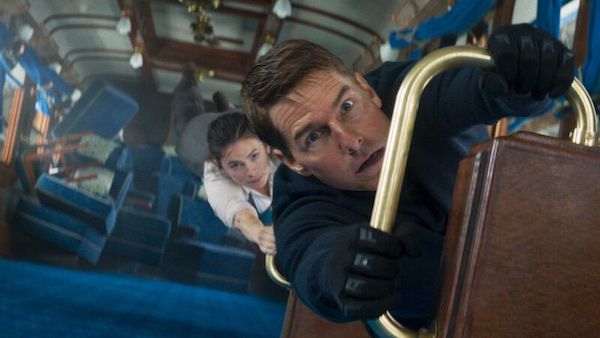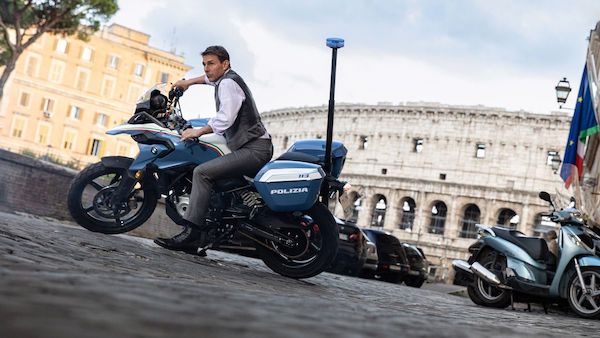Film Review: “Mission: Impossible — Dead Reckoning Part One” — The Best Ever
By Michael Marano
The acts of reinvention in Mission: Impossible–Dead Reckoning Part One are revelatory, object lessons for how all future summer sequels can be written.
Mission: Impossible — Dead Reckoning Part One, directed by Christopher McQuarrie.

A scene from Mission: Impossible — Dead Reckoning Part One.
How screwed up is it that it takes the world’s most prominent Scientologist to make the definitive blockbuster bashing QAnon?
Much as I like (most of) Tom Cruise’s Mission: Impossible movies, the retreaded premise of “Bad Secret Agents Go Rogue, So Cruise’s Team Must Go Rogue to Catch Them” was utterly flogged to death in the last entry, Mission: Impossible–Fallout. The premise became so interchangeable that, if you took all six of the previous films in the series, put them in one of those old multi-DVD players, and played random scenes from each film, you’d generate a semi-coherent plot.
Sort of like how AI gobbles premises and scenes and spits them out into semi-coherent stories.
So it’s fitting that the main antagonist of Mission: Impossible — Dead Reckoning Part One (hereafter, M:I 7) is a HAL 9000-like AI called The Entity that makes reality itself, truth itself, go rogue. It sows anarchy and destruction through the same kind of disinformation that sent a pod of neck-bearded knuckle-walkers to the Capitol to overthrow the US Government. Yes, M:I 7 gobbles up elements from bunches of other movies — The Billion Dollar Brain, Colossus: The Forbin Project, The Italian Job, The Hunt for Red October, From Russia, with Love… even Don’t Look Now and Avengers: The Age of Ultron, if you squint right. But it brilliantly reinvents each of those elements, making them fresh, dynamic, thrilling, and literally breathtaking (there were moments I had to remind myself to exhale).
What kind of reinvention?
I’d rather have smoldering bamboo slivers shoved under my nails than spoil the thrills of M:I 7, so I’ll just say producer Cruise and his longtime collaborator Christopher McQuarrie take tropes we’re bored with and rework them exponentially, by which I mean a tired plot element we’ve seen with two characters is crafted to work with four or five characters. A clichéd action sequence we’ve seen recycled since the ’60s that engages two participants is orchestrated to engage four. Double crosses are fun plot points in thrillers. Here, we have triple and quadruple crosses.
And these moments of reinvention are not just gimmicks of the “More is More!” school of Hollywood tentpole sequel production. None of these reinventions that make familiar tropes newly dynamic feel phony or tacked on. And that is because they’re integral to the plot. These reinventions took human imagination, an understanding of suspenseful storytelling based on the experience of watching (and making) other films that no AI could duplicate.
The point is that it took crafted writing chops to orchestrate these reinventions. I emphasize this to contrast the glories of M:I 7 with the ditchwater dullness of Indiana Jones and the Dial of Destiny. Sitting through Dial of Destiny, you can see the notes from corporate studio drones (guys with mega-douchey names like “Chad,” “Aspen,” “Bryce,” or “Chip” who sport haircuts that cost more than most people’s monthly rent) insisting that the film’s plot elements be cannibalized and/or regurgitated from earlier efforts. To the point that what should have been a deeply felt scene, an emotional payoff that required actual writing, is simply cut and pasted from another Indiana Jones movie, much in the way an AI would steal the dialogue and call it a day. Both Dial of Destiny and M:I 7 pilfer from John Frankenheimer’s The Train. Dial of Destiny‘s theft feels diluted, tired, thin, tacked on. M:I 7‘s theft feels like a concentration, an adrenaline-rich mainlining of the elements that made The Train so great, repurposed and seamlessly integrated into the plot.
The acts of reinvention in M:I 7 are revelatory — object lessons for how all future summer sequels can be written.
There’s a weight to M:I 7 that other entries in the series lack. The threat of The Entity, disinformation personified, that can destroy “our carefully constructed digital reality,” has social and thematic substance baked into it. Governments don’t want to destroy The Entity, they want to control it, which is like trying to keep the Joker’s behavior in check by calling him in for a meeting with Sally in HR, so good luck with that. The macro-scale, global threat of The Entity is about manipulating our perceptions of reality, “eradicating right and wrong.” In the film it is played out on a micro-scale via the interpersonal betrayals and ratfuckings of the characters, leading to existential moral crises in a “post-truth” world defined by “alternative facts” that allow algorithms to predict and manipulate human action.

Tom Cruise going after The Entity in Mission: Impossible — Dead Reckoning Part One.
Though The Entity is a nonphysical adversary, it provides an ever-escalating sense of a “tangibly intangible” threat. In glorious contrast to the untouchable abstraction that is The Entity are the concrete virtues of MI:7′s on-location filming, the practical effects, and absurdly dangerous stunts. This is a brilliantly constructed action movie about confronting a threat incapable of any action on its own.
Yeah, M:I 7 has truly clunky exposition, including a Star Trek-like log entry from a naval officer to get the audience up to speed and a few moments in which characters recap stuff everyone present should already know, to say nothing of new plot points just sort of verbally dropped on the table as if everyone were sitting at the Council of Elrond.
But these are forgivable lapses. Too often with summer blockbusters, you walk out feeling like you settled for what you were given (especially if it’s a sequel). With M:I 7, there’s no sense of having to make d0. I know that seems an absurd thing to say about a movie with “Part One” in its title. But M:I 7 ends at a point that in no way feels like a cheat. And, after M:I 7‘s two-and-a-half hour runtime, even though I felt like I hadn’t settled for anything, I’d have gladly sat through Dead Reckoning Part Two that instant.
Hands down, this is the best Mission: Impossible movie. I have no idea how Part Two can top this, but I have every confidence it will.
Novelist, editor, critic, personal trainer, and writing coach Michael Marano had a shitty retail job in his early 20s, and would take the bus home just in time to unwind with reruns of the old Mission: Impossible show on a local UHF station… leading to his ongoing affection for the franchise.
